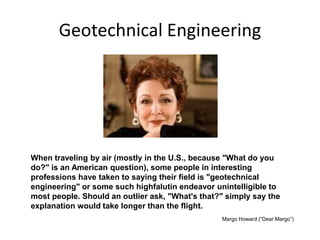Not known Factual Statements About Geotheta
Table of ContentsSome Ideas on Geotheta You Should KnowThe Only Guide to GeothetaExcitement About GeothetaWhat Does Geotheta Mean?Excitement About Geotheta

They conduct site examinations, accumulate examples, carry out research laboratory examinations, and analyze data to evaluate the viability of the ground for building and construction tasks - Geo Tech Engineering. Based upon their searchings for, geotechnical designers provide recommendations for foundation design, slope security, retaining frameworks, and reduction of geotechnical threats. They team up with other experts, such as architects, architectural designers, and building groups, to make certain that geotechnical factors to consider are integrated into the general job style and implementation
By examining the actions and homes of soil and rock, they can identify possible geotechnical hazards such as landslides, dirt settlement, or slope instability. Their experience helps prevent failings or mishaps that could jeopardize lives and residential or commercial property. Here are some thorough responsibilities and responsibilities of a geotechnical engineer: Website Investigation: Geotechnical engineers conduct site investigations to collect information on subsurface problems.
They translate the information to recognize the homes and actions of the dirt and rock, including their strength, permeability, compaction qualities, and groundwater problems. Geotechnical Analysis and Style: Geotechnical designers assess the information accumulated during website investigations to examine the stability and viability of the site for building jobs. They do geotechnical computations and modeling to evaluate variables such as birthing capacity, settlement, incline stability, lateral planet pressures, and groundwater flow.
Unknown Facts About Geotheta
Foundation Layout: Geotechnical designers play an important function in designing foundations that can safely sustain the desired framework. They assess the dirt problems and lots needs to determine the suitable foundation kind, such as superficial structures (e.g., grounds), deep structures (e.g (https://www.intensedebate.com/people/geotheta)., piles), or specialized techniques like soil enhancement. They consider elements such as settlement limitations, bearing ability, and soil-structure communication to establish optimal structure layouts
They examine building and construction strategies, screen site activities, and carry out area evaluations to validate that the design referrals are complied with. If unpredicted geotechnical problems occur, they assess the scenario and provide suggestions for remediation or changes to the design. Risk Evaluation and Reduction: Geotechnical engineers analyze geotechnical threats and dangers connected with the project website, such as landslides, liquefaction, or soil disintegration.

Collaboration and Interaction: Geotechnical engineers function closely with other specialists included in a project, such as designers, architectural designers, and building groups. Efficient interaction and collaboration are important to incorporate geotechnical factors to consider right into the general task style and building procedure. Geotechnical engineers give technical expertise, solution questions, and ensure that geotechnical requirements are met.
4 Easy Facts About Geotheta Described
Right here are some types of geotechnical designers: Foundation Designer: Foundation designers concentrate on developing and examining structures for frameworks. They assess the dirt conditions, tons requirements, and website features to establish the most proper foundation type and style, such as shallow foundations, deep structures, or specialized methods like stack foundations.
They examine the variables influencing slope stability, such as soil homes, groundwater conditions, and slope geometry, and establish methods to stop incline failings and mitigate threats. Earthquake Engineer: Earthquake engineers focus on analyzing and developing structures to hold up against seismic pressures. They assess the seismic risk of a site, review dirt liquefaction possibility, and establish seismic style standards to ensure the safety and security and strength of structures during earthquakes.
They do area testing, gather examples, and analyze the collected information to define the soil homes, geologic formations, and groundwater conditions at a website. Geotechnical Instrumentation Engineer: Geotechnical instrumentation engineers focus on surveillance and gauging the habits of dirt, rock, and frameworks. They install and preserve instrumentation systems that keep track of elements such as soil negotiation, groundwater degrees, incline movements, and structural variations to analyze performance and offer early cautions of possible concerns.
8 Simple Techniques For Geotheta
They perform examinations such as triaxial examinations, loan consolidation examinations, straight shear examinations, and leaks in the structure examinations to collect information for geotechnical analysis and design. Geosynthetics Designer: Geosynthetics designers focus on the design and application of geosynthetic products, such as geotextiles, geogrids, and geomembranes. They make use of these products to improve dirt security, enhance inclines, provide drain remedies, and control disintegration.
They tend to be investigative people, which implies they're intellectual, reflective, and inquisitive. They are interested, methodical, reasonable, logical, and logical. A few of them are also social, suggesting they're kind, charitable, cooperative, client, caring, handy, empathetic, sensible, and pleasant. Does this noise like you? Take our free occupation examination to figure out if geotechnical engineer is among your top job suits.
In the office atmosphere, geotechnical designers use specialized software program tools to carry out estimations, create designs, and examine data. They prepare reports, testimonial job specifications, interact with clients and employee, and coordinate task tasks. The workplace setting provides a conducive environment for study, analysis, and cooperation with various other professionals associated with the project.
The Only Guide to Geotheta
They frequently see project sites to carry out website investigations, analyze geotechnical problems, and collect data for evaluation. These gos to entail traveling to various areas, in some cases in remote or tough terrains. Geotechnical designers might do dirt sampling, conduct tests, and screen building and construction tasks to ensure that the geotechnical facets of the task are being implemented appropriately.
Geotechnical designers likewise operate in specialized geotechnical labs. In these centers, they conduct experiments, carry out examinations on soil and rock examples, and assess the engineering residential properties of the materials. Geotechnical laboratory designers function extensively in these atmospheres, dealing with screening tools, running tools, and recording information. They work together with various other research laboratory personnel to guarantee accurate and trusted screening results.